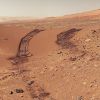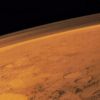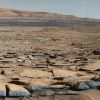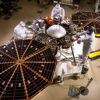-
 +17 +3
+17 +3Mars on Earth: Simulation tests in remote desert of Oman
Mars on Earth: Simulation tests in remote desert of Oman - Two scientists in spacesuits, stark white against the auburn terrain of desolate plains and dunes, test a geo-radar built to map Mars by dragging the flat box across the rocky sand. When the geo-radar stops working, the two walk back to their all-terrain vehicles and radio colleagues at their nearby base camp for guidance. They can't turn to their mission command, far off in the Alps, because communications from there are delayed 10 minutes.
-
 +29 +5
+29 +5How astronauts prepare for a Mars voyage in the desert of Israel
The Desert Mars Analog Ramon Station project will teach astronauts about research and exploration on Mars.
-
 +31 +4
+31 +4Opportunity Rover Celebrates 5,000 Days on Mars
NASA's long-lived Mars rover Opportunity has just rolled past another big milestone — 5,000 days on the Red Planet.
-
 +14 +3
+14 +3Life exists in the driest desert on Earth. It could exist on Mars, too.
Desert organisms flourish in rare rains and then go dormant when it's dry. Mars bacteria could do the same.
-
 +23 +4
+23 +4European Space Agency's ExoMars Orbiter is about to start sniffing the Red Planet for signs of life
In March of 2016 the European Space Agency - in collaboration with Roscosmos - launched The ExoMars Trace Gas Orbiter sending it on its way to the mysterious red planet that orbits our Sun, Mars. Its mission? To look for signs of life on the Red Giant that has held the interest of astronomers for centuries since first being discovered in the 17th century by Galileo Galilei.
-
 +33 +8
+33 +8Elon Musk still thinks a Mars colony will save us from a future dark age
The head of SpaceX and Tesla came to SXSW this week and gave a grave talk about the future of humanity
-
 +31 +8
+31 +8Stunning Mars images, from Curiosity
The Curiosity rover has sent back some beautiful new images of the foothills of Mount Sharp in Gale crater on Mars.
-
 +3 +1
+3 +1Comets and asteroids shower Mars with organics
For decades, astronomers suspected that Mars might be teeming with organics, which are carbon-based molecules like proteins, carbohydrates, and nucleic acids. However, it wasn’t until 2015 that the Mars Curiosity rover uncovered the first evidence showing these life-supporting compounds were not only present, but also likely scattered all over the Red Planet.
-
 +15 +6
+15 +6Curiosity Rover: 2,000 Days on Mars
The Nasa robot this week celebrates 2,000 martian days investigating the surface of the Red Planet.
-
 +16 +1
+16 +1Surviving Mars review: Spreading humanity to the stars isn't easy
Surviving Mars has a lot of interface annoyances and other small issues, but its blend of optimism and dread makes a compelling foundation for a city/colony builder.
-
 +8 +2
+8 +2Mars Colony Would Be a Hedge Against World War III, Elon Musk Says
Humanity's brutal and bellicose past provides ample justification for pursuing settlements on the moon and Mars, Elon Musk says. The billionaire entrepreneur has long stressed that he founded SpaceX in 2002 primarily to help make humanity a multiplanet species — a giant leap that would render us much less vulnerable to extinction.
-
 +15 +2
+15 +2Elon Musk, Jeff Bezos and the new race for space
The pace of technological progress has been a little underwhelming in recent decades. Let's be honest: Checking your Facebook feed in the bathroom isn't something to be proud of. Not in the way we were proud of putting a man on the moon. Or breaking the sound barrier. Or democratizing air travel.
-
 +40 +8
+40 +8Mars One Is a "Money Grab" Where Everyone Loses
A three month investigation into the biggest scam in the universe.
-
 +26 +1
+26 +1Mars One Is a "Money Grab" Where Everyone Loses
n 2012, Josh Richards was not a soldier, or a miner, or a Mars One hopeful. He was Keith, the Anger Management Koala. The bit was exactly what it sounds like. Richards — who describes himself as a “short, obnoxious, ginger Australian” — would dress up as his country’s most notorious marsupial and swear at a live audience. A former soldier-turned-traveling comic, he says being Keith was oddly therapeutic.
-
 +20 +3
+20 +3Water may have killed Mars’ magnetic field
Mars’ missing magnetic field may have drowned in the planet’s core. An excess of hydrogen, split off from water molecules and stored in the Martian mantle, could have shut down convection, switching the magnetic field off forever, planetary scientist Joseph O’Rourke proposed March 21 at the Lunar and Planetary Science Conference.
-
 +20 +2
+20 +2NASA looking into robo-bees to explore Mars from the air
NASA has just green-lighted a research project to investigate how swarms of robotic bees might spread out over the surface of Mars, equipping our exploration efforts with a much wider net.
-
 +17 +3
+17 +3Breathtaking Mars: NASA Photo Reveals Stunning Dune Gullies In Matara Crater
NASA’s Mars Reconnaissance Orbiter (MRO) has captured an incredible snapshot of the Matara Crater on Mars. The image, taken by the High Resolution Imaging Science Experiment (HiRISE) camera aboard the MRO, unveils spectacular gully formations on sand dunes inside the Martian crater.
-
 +15 +2
+15 +2Agencies aim to bring back rocks from Mars
The US and European space agencies are edging towards a joint mission to bring back rock and soil samples from Mars. Nasa and Esa have signed a letter of intent that could lead to the first "round trip" to another planet. The move was announced as a meeting in Berlin, Germany, discussed the science goals and feasibility of a Mars Sample Return (MSR) mission.
-
 +18 +6
+18 +6Mars Quakes Set to Reveal Tantalizing Clues to Planet's Early Years
NASA’s Mars InSight mission will listen for seismic activity to uncover details of Red Planet’s mysterious core
-
 +21 +5
+21 +5Why NASA's Next Mars Lander Will Launch from California Instead of Florida
NASA is set to launch its next Mars lander, InSight, early Saturday morning. But something’s different about this launch. It’s taking place on the West Coast, at Vandenberg Air Force Base in California.
Submit a link
Start a discussion




















